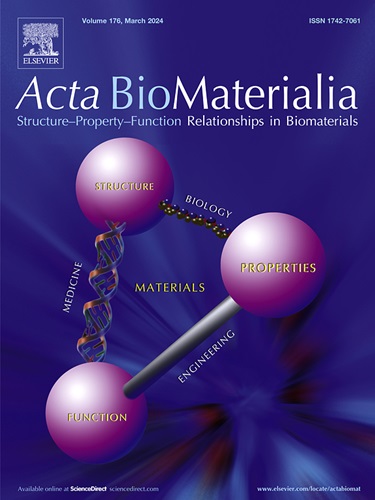Microindentation reveals softening of the equatorial and anterior sclera during early myopia development in tree shrew eyes
IF 9.6
1区 医学
Q1 ENGINEERING, BIOMEDICAL
引用次数: 0
Abstract
Myopia has reached epidemic levels worldwide and significantly increases the risk for blinding diseases such as glaucoma, making it a pressing global health concern. Myopia is commonly associated with biomechanical weakening and remodeling of the sclera, resulting in an excessively elongated eye relative to its optical system. The exact regions of scleral remodeling and tissue softening remain unclear. The purpose of this study was to establish a microindentation testing approach for spatial mapping of scleral stiffness and localization of softened regions. Microindentation tests were performed across entire flat-mounted scleral samples obtained from juvenile tree shrews with either normal visual experience or four days of monocular -5 D lens treatment to induce myopia in one eye, whereas the other eye served as control. Inverse finite element analyses were performed to estimate the apparent modulus at each indentation location, while accounting for large deformations. The generated stiffness maps revealed that scleral stiffness increased with distance from the posterior pole. Compared to normal and control eyes, scleral stiffness was significantly reduced in myopic eyes at the equatorial and anterior scleral regions, but not at the posterior pole. This result was surprising because the posterior pole has previously been regarded as the primary site of scleral remodeling and biomechanical weakening in myopia. Regions that exhibited significant changes in stiffness were also identified as the thinnest scleral regions, suggesting that scleral softening in myopia begins in regions that are most vulnerable to excessive stretching. It remains unclear whether scleral softening at the equatorial and anterior regions during early stages of myopia development is a precursor of biomechanical weakening of the sclera as myopia progresses. This study introduces an indentation-based approach to map scleral stiffness across the entire sclera of tree shrew eyes thus providing higher spatial resolution compared to previous work. This novel approach provides insights into how and where myopic changes may begin, highlighting potential targets for early interventions, such as scleral crosslinking, at structurally vulnerable regions.

微凹痕显示树鼩眼在早期近视发展过程中赤道和前巩膜软化。
近视在世界范围内已达到流行病水平,并显著增加了青光眼等致盲疾病的风险,使其成为一个紧迫的全球卫生问题。近视通常与巩膜的生物力学弱化和重塑有关,导致眼睛相对于其光学系统过度拉长。巩膜重塑和组织软化的确切区域尚不清楚。本研究的目的是建立一种微压痕测试方法,用于巩膜刚度的空间映射和软化区域的定位。研究人员对来自幼年树鼩的整个平板巩膜样本进行了微压痕测试,这些树鼩要么具有正常的视觉经验,要么接受了四天的单眼-5 D晶状体治疗,以诱导一只眼睛近视,而另一只眼睛作为对照。在考虑大变形的情况下,进行了反有限元分析,以估计每个压痕位置的表观模量。生成的刚度图显示巩膜刚度随距后极距离的增加而增加。与正常眼和对照眼相比,近视眼的巩膜僵硬度在赤道和前巩膜区显著降低,但在后极无明显降低。这个结果是令人惊讶的,因为后极以前被认为是近视的巩膜重塑和生物力学减弱的主要部位。僵硬度发生显著变化的区域也被认为是最薄的巩膜区域,这表明近视的巩膜软化始于最容易受到过度拉伸的区域。目前尚不清楚,在近视发展的早期阶段,赤道和前部区域的巩膜软化是否预示着随着近视的发展,巩膜的生物力学减弱。本研究引入了一种基于压痕的方法来绘制树鼩眼整个巩膜的巩膜硬度图,从而提供比以往工作更高的空间分辨率。我们的研究结果表明,巩膜硬度随着离后极的距离增加而增加,而早期近视减少了赤道和巩膜前部的硬度。令人惊讶的是,后极没有表现出明显的变化,这挑战了它是近视重建的主要部位的观点。这项研究提供了关于近视变化如何以及在何处开始的见解,突出了早期干预的潜在目标,例如在结构脆弱区域的巩膜交联。
本文章由计算机程序翻译,如有差异,请以英文原文为准。
求助全文
约1分钟内获得全文
求助全文
来源期刊

Acta Biomaterialia
工程技术-材料科学:生物材料
CiteScore
16.80
自引率
3.10%
发文量
776
审稿时长
30 days
期刊介绍:
Acta Biomaterialia is a monthly peer-reviewed scientific journal published by Elsevier. The journal was established in January 2005. The editor-in-chief is W.R. Wagner (University of Pittsburgh). The journal covers research in biomaterials science, including the interrelationship of biomaterial structure and function from macroscale to nanoscale. Topical coverage includes biomedical and biocompatible materials.
 求助内容:
求助内容: 应助结果提醒方式:
应助结果提醒方式:


